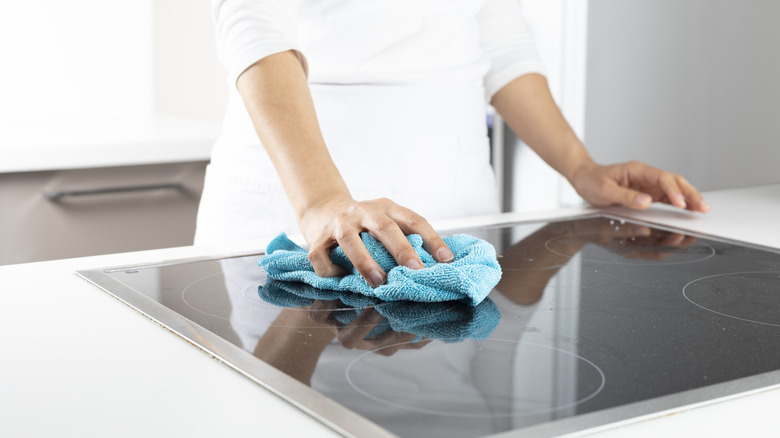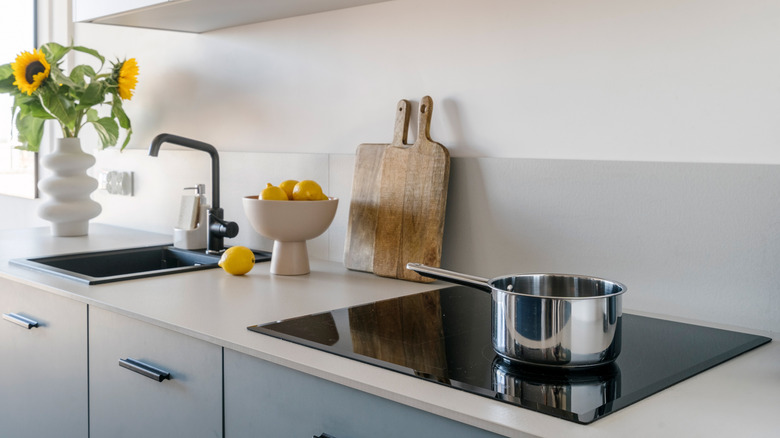Yes, The Toothpaste Hack For Glass Cooktop Scratches Can Work (But There Are Caveats)
If your sleek glass cooktop is starting to show signs of wear (think fine scratches that catch the light and drive you nuts), you're not alone. These smooth stovetops look modern and stylish, but their polished surfaces are easily marred by everyday habits like sliding pots across them or using the wrong cleaning tools. One unexpected fix that's gained popularity? Toothpaste. Specifically, plain white toothpaste containing baking soda can help reduce the appearance of surface scratches. The secret lies in its gentle abrasiveness. It turns out the same quality that helps clean your teeth can also act as a mild polishing agent on glass.
But before you squeeze out a glob and start scrubbing, keep in mind: This hack isn't a silver bullet. It only works on shallow, superficial scratches — the kind you can feel with a fingernail but that don't cut deep into the top layer. It also needs the right kind of toothpaste (no gels). Done correctly, this unexpected hack will have your glass stovetop sparkling new without needing to replace anything. Consider it a budget-friendly alternative to commercial scratch removers.
How to use toothpaste to buff out shallow scratches
To start, make sure the cooktop is turned off, completely cool, and free from any food debris, grease, or residue. Once it's ready, apply a small amount of plain white toothpaste (about the size of a pea or nickel) to a soft, lint-free cloth. Do not use gel toothpaste or whitening formulas, as they may contain additives that are too abrasive for this task. Using light pressure and small, circular motions, buff the toothpaste into the scratched area. You're not trying to scrub like you would a burnt pot — think gentle polishing instead. Keep working over the area for a minute or two, and then use a damp cloth or sponge to remove the toothpaste. Once the surface is clean, dry it thoroughly and take a look.
If you're unhappy with the result, you can try the process again — though limit it to no more than two rounds to avoid dulling the finish. Even mild abrasives, like toothpaste, can dull the finish if overused. If the scratches still aren't buffed out, they're probably too deep for this method. But if they were shallow to begin with, give the surface a final clean. Just be sure to avoid the biggest mistakes when cleaning a glass-top stove.
How to prevent future scratches — and when to use pro-grade solutions
Once your cooktop is looking better, it's worth taking a few steps to keep it that way. Most glass cooktop scratches happen during daily use, not from neglect. To prevent new marks, avoid sliding cookware across the surface, especially cast iron or ceramic-bottomed pots. Instead, lift and place your pots and pans gently. Also, always wipe away food debris before cooking. Even a few crumbs can grind into the finish under a heavy pan. To prevent cleaning scratches on your glass stovetop, skip abrasive pads and powders. Use a soft cloth or sponge and a gentle, non-scratching cleaner made for glass cooktops. And resist the urge to use sharp tools to scrape off burnt-on messes — a plastic scraper or specialty cooktop razor is a safer bet.
Not seeing the results you hoped for with toothpaste? That's your cue to consider a dedicated glass stove polish. These commercial products are designed to tackle deeper blemishes and offer a protective finish that can make your cooktop more resistant to future marks. They're pricier than toothpaste, but often more effective — especially for tougher jobs. Either way, staying gentle and proactive is the best long-term strategy for keeping that shiny surface scratch-free.

